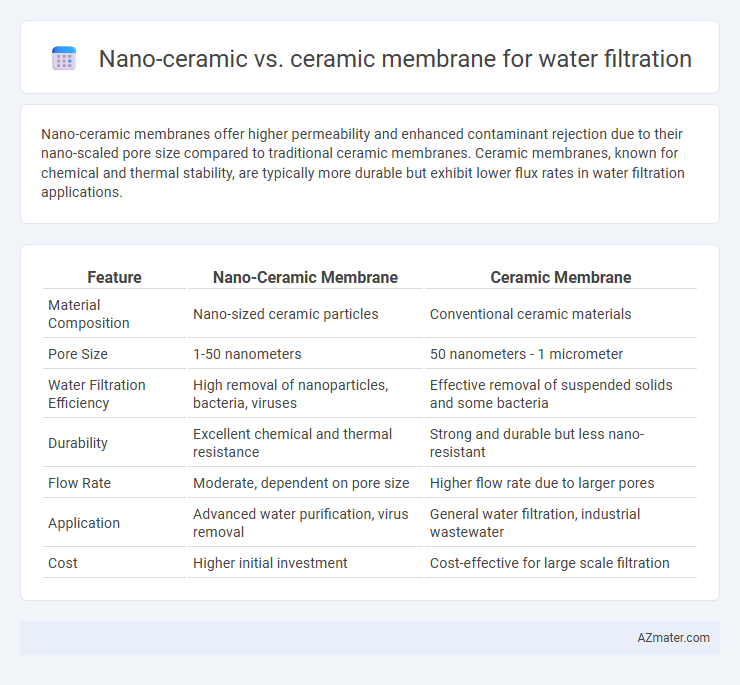Nano-ceramic membranes offer higher permeability and enhanced contaminant rejection due to their nano-scaled pore size compared to traditional ceramic membranes. Ceramic membranes, known for chemical and thermal stability, are typically more durable but exhibit lower flux rates in water filtration applications.
Table of Comparison
| Feature | Nano-Ceramic Membrane | Ceramic Membrane |
|---|---|---|
| Material Composition | Nano-sized ceramic particles | Conventional ceramic materials |
| Pore Size | 1-50 nanometers | 50 nanometers - 1 micrometer |
| Water Filtration Efficiency | High removal of nanoparticles, bacteria, viruses | Effective removal of suspended solids and some bacteria |
| Durability | Excellent chemical and thermal resistance | Strong and durable but less nano-resistant |
| Flow Rate | Moderate, dependent on pore size | Higher flow rate due to larger pores |
| Application | Advanced water purification, virus removal | General water filtration, industrial wastewater |
| Cost | Higher initial investment | Cost-effective for large scale filtration |
Introduction to Water Filtration Technologies
Nano-ceramic membranes offer superior water filtration performance due to their ultra-fine pore structure, enabling removal of contaminants at the nanoscale and enhancing filtration efficiency beyond conventional ceramic membranes. Ceramic membranes, composed primarily of materials like alumina, zirconia, or titania, provide robust chemical and thermal resistance, making them ideal for harsh water treatment conditions. Both technologies play crucial roles in advanced water filtration systems, targeting the removal of particles, bacteria, and organic compounds to ensure safe and clean water supply.
What Are Nano-Ceramic Membranes?
Nano-ceramic membranes are advanced filtration materials composed of nanoparticles fused into a ceramic matrix, offering superior pore size control and enhanced permeability compared to traditional ceramic membranes. These membranes excel in filtering contaminants at the molecular level, including viruses, bacteria, and fine particulates, making them highly effective for water purification and wastewater treatment. Their nano-scale pores provide improved selectivity, durability, and resistance to fouling, optimizing water filtration efficiency in various industrial and environmental applications.
What Are Conventional Ceramic Membranes?
Conventional ceramic membranes are filtration materials composed primarily of inorganic compounds such as alumina, silica, or zirconia, known for their robust thermal and chemical stability in water treatment processes. These membranes feature a porous structure with pore sizes typically ranging from microfiltration to ultrafiltration scales, enabling efficient removal of suspended solids, bacteria, and other contaminants. Their durability and resistance to harsh cleaning agents make them ideal for long-term water filtration applications in industrial and municipal settings.
Key Material Differences: Nano-ceramic vs Ceramic Membranes
Nano-ceramic membranes utilize nanoscale ceramic particles that provide higher permeability and enhanced fouling resistance compared to traditional ceramic membranes made from micro- or mesoporous alumina, zirconia, or titania. The smaller pore size distribution in nano-ceramics enables superior particle rejection and improved filtration efficiency for contaminants such as bacteria, viruses, and organic molecules. Ceramic membranes typically exhibit greater mechanical strength and chemical stability, while nano-ceramic membranes offer optimized surface properties for applications requiring ultrafiltration or nanofiltration in water treatment.
Filtration Efficiency and Particle Retention
Nano-ceramic membranes exhibit superior filtration efficiency compared to traditional ceramic membranes, achieving particle retention at the nanoscale level, typically filtering particles as small as 0.01 microns. Ceramic membranes generally retain particles down to 0.1 microns but lack the enhanced surface area and pore structure refinement found in nano-ceramic variants, resulting in lower overall filtration precision. The advanced nano-ceramic technology promotes higher contaminant rejection rates and extended membrane lifespan due to improved fouling resistance and structural stability.
Permeability and Water Flux Performance
Nano-ceramic membranes exhibit higher permeability and water flux performance compared to conventional ceramic membranes due to their smaller pore size and enhanced surface properties, enabling more efficient filtration and faster water processing. The nano-ceramic structure allows for greater contaminant rejection while maintaining a higher flow rate, optimizing filtration effectiveness without compromising throughput. Advanced nano-ceramic membranes also demonstrate improved fouling resistance, which contributes to sustained high water flux and reduced maintenance in water filtration applications.
Durability and Chemical Resistance
Nano-ceramic membranes exhibit superior durability due to their enhanced mechanical strength and resistance to abrasion compared to traditional ceramic membranes. Their nano-structured surface increases resistance to chemical degradation, allowing effective filtration in harsh chemical environments such as acidic or alkaline wastewater. Ceramic membranes, while robust, are generally less resistant to chemical attack and may degrade faster under extreme pH or aggressive cleaning agents, impacting long-term performance.
Cost Comparison: Nano-ceramic vs Ceramic Membranes
Nano-ceramic membranes typically incur higher initial costs than traditional ceramic membranes due to advanced fabrication techniques and enhanced filtration properties. Ceramic membranes offer a more cost-effective option for large-scale water treatment applications, benefiting from lower production expenses and longer operational lifespans. Maintenance and replacement costs for nano-ceramic membranes can be reduced by their increased durability and fouling resistance, potentially offsetting higher upfront investments over time.
Real-World Applications in Water Treatment
Nano-ceramic membranes offer superior filtration efficiency by removing viruses, bacteria, and organic contaminants at the nanoscale, making them ideal for advanced water treatment plants and industrial wastewater recycling. Ceramic membranes, known for their robustness and chemical resistance, are commonly employed in municipal water treatment and harsh environment applications where durability and long service life are critical. Both technologies enhance water quality and safety but are selected based on specific operational demands such as particle size retention, fouling resistance, and maintenance requirements.
Choosing the Right Membrane for Your Needs
Nano-ceramic membranes provide superior filtration efficiency and durability for water treatment, effectively removing contaminants as small as 1-10 nanometers, making them ideal for advanced purification tasks. Ceramic membranes, with their robust chemical and thermal resistance, excel in industrial applications requiring high fouling resistance and long service life. Choosing the right membrane depends on the specific water quality, operational conditions, and maintenance capabilities, ensuring optimal performance and cost-effectiveness in filtration systems.

Infographic: Nano-ceramic vs Ceramic membrane for Water Filtration
 azmater.com
azmater.com